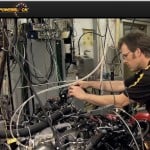Four graduate students are going to Lansing for Graduate Education Day, Thursday, March 29. Governor Rick Snyder has declared the week of March 26 as Graduate Education Week, and more than 50 students from universities and colleges across the state will meet with legislators at the Capitol Building in Lansing.
Represenmting Michigan Tech and ME-EM, Mark Hopkins, a PhD candidate in mechanical engineering from Charlotte. He will be discussing his work on in-space electric rockets.
 ‘Horsepower TV’, a Spike TV program about building hot rod engines, showed Michigan Tech research being done testing engines running on E85 fuels.
‘Horsepower TV’, a Spike TV program about building hot rod engines, showed Michigan Tech research being done testing engines running on E85 fuels.
The episode is posted online at: Horsepower TV
The segment about E85 is at 13 minutes.
 The 2012 Society of Automotive Engineers SAE Clean Snowmobile Challenge is being held at Michigan Technological University Houghton, Michigan. Links to Photos and Videos of 2012 SAE Clean Snowmobile Challenge Action can be found at 2012 SAE Clean Snowmobile Challenge Videos
The 2012 Society of Automotive Engineers SAE Clean Snowmobile Challenge is being held at Michigan Technological University Houghton, Michigan. Links to Photos and Videos of 2012 SAE Clean Snowmobile Challenge Action can be found at 2012 SAE Clean Snowmobile Challenge Videos
Dr. Scott A Miers had been selected to receive the 2012 Society of Automotive Engineers (SAE) Ralph R. Teetor Educational Award. In the award letter it states “The credentials and standards of excellence in education of this year’s candidates were extremely high and brought about some very keen competition. Your outstanding contributions have distinguished you as one of the top engineering educators.” As a recipient Scott is invited as a guest for the week of the 2012 SAE World Congress which begins on April 24th in Detroit, MI, including the award ceremony on Tuesday of that week, and will be presented with a plaque.
 Bill Shapton Featured in Michigan Tech Magazine: An engine of change (PDF)
Bill Shapton Featured in Michigan Tech Magazine: An engine of change (PDF)
A bumpy ride in the bush in an off-road vehicle has paved the way for the industrial readiness of engineering students nationwide.
See the historic video clips from 1970s SAE Collegiate Design competitions
 Members of Michigan Tech’s chapter of the National Society of Black Engineers (NSBE) are in Detroit to participate in an alternative spring break 2012 week. Eight members of the Michigan Tech student chapter of the NSBE will visit six middle schools and one high school to talk with students. They will also conduct Family Engineering events at three schools. Family Engineering includes fun, hands-on activities for the whole family, such as “Mining For Chocolate” and “Glue Is The Clue.” The program, developed at Michigan Tech and now available across Michigan and nationwide, is designed to engage and inspire young people and their families to consider careers in engineering and science. Read More
Members of Michigan Tech’s chapter of the National Society of Black Engineers (NSBE) are in Detroit to participate in an alternative spring break 2012 week. Eight members of the Michigan Tech student chapter of the NSBE will visit six middle schools and one high school to talk with students. They will also conduct Family Engineering events at three schools. Family Engineering includes fun, hands-on activities for the whole family, such as “Mining For Chocolate” and “Glue Is The Clue.” The program, developed at Michigan Tech and now available across Michigan and nationwide, is designed to engage and inspire young people and their families to consider careers in engineering and science. Read More
UPDATE: See a Video about Engineering Students Spring Break to Detroit Schools
Thursday March 22, 2012 4:00-5:00 p.m.
ME-EM building, Room 112
Greg McKenna
Horn Professor, Department of Chemical Engineering, Texas Tech University
Dr. Gregory B. McKenna has a reputation as a pioneering researcher in four areas of polymer and plastics science and technology: Physical Aging and Structural Recovery of Polymer Glasses, Solid Mechanics and Nonlinear Viscoelasticity of Polymers, Thermodynamics and Mechanics of Elastomers and Gels, Molecular Rheology.
He received his Bachelor’s in Engineering Mechanics at the U.S. Air Force Academy, and his MS in the area of composite materials from MIT. He entered active duty as a test and evaluation engineer at Hill Air Force Base in Ogden, Utah. In 1976 he received his Ph.D. in Materials Science and Engineering at the University of Utah. Dr. McKenna started at the National Bureau of Standards (now called NIST) as a National Research Council Postdoc and accepted a permanent position as a staff scientist in 1977. He served
as the head of the Structure and Mechanics Group in the Polymers Division at NIST from 1992-99. In 1989 Dr. McKenna became a Fellow of the American Physical Society and was the recipient of the NIST E.U. Condon Award for excellence in technical exposition for his classic review article “Glass Formation and Glassy Behavior.”
In 1998, he was elected a Fellow of the Society of Plastics Engineers.
After NIST, he joined Texas Tech University as a Professor in the Department of Chemical Engineering and the John R. Bradford Endowed Chair in Engineering. In 2005 he became a Paul Whitfield Horn Professor at TTU.
He is the 2009 recipient of the Bingham Medal of the Society of Rheology, has received the International Award of the Society of Plastics Engineers, and the Mettler Toledo Award from the North American Thermal Analysis Society. He served on the Governing Board of the American Institute of Physics, the Executive Committees of the
Society of Rheology and The Division of High Polymer Physics (DHPP) of the American Physical Society. He was the Chairman of the DHPP, the Society of Engineering Science, and the Polymer Analysis Division of the Society of Plastics Engineers. Currently he is vice-president of the Society of Rheology.
Title: Using Mechanics to Interrogate the Physics of Soft Matter:
From the Glassy to the Rubbery States and from the Macro-scale to the Nano-scale
Abstract: Mechanical measurements offer a unique means of interrogating the physics of am orphous glass-formers and rubbery polymers. Here we present several vignettes to demonstrate the ability of both classical and novel rheological experiments to resolve important questions in condensed matter physics. First, results from torque and normal force measurements aimed at understanding the thermodynamics and m echanics of polymer networks in both dry and swollen states are presented. In particular, we examine the validity of the Frenkel-Flory-Rehner theory of rubber network swelling. Torsion and normal force measurements are also described for a series of polymeric glasses that exhibit similar shear moduli but, surprisingly, very different normal force responses, with one set of materials showing extreme deviations from neo-Hookean behavior and the other being close to neo-Hookean. We then describe the use of a novel torsional dilatometer, which allows simultaneous m easurement of mechanical properties and volume recovery, to investigate the aging and rejuvenation behaviors of glassy polymers.
The temperature dependence of dynamics is probed in glassy polymers that have been aged into equilibrium below the nom inal glass transition temperature and evidence is presented that time-scale divergence m ay not be a true signature of the glass transition itself. Finally, we describe a reduction in scale of the classical m embrane inflation test to allow measurement of the biaxial creep compliance of nanometer thick polymeric films using an atomic force microscope. In each instance em phasis is placed on how the measurements are designed to interrogate the physics of interest in the materials investigated.
Michigan Tech’s Department of Mechanical Engineering-Engineering Mechanics jumped from 48th to 44th in the US News & World Report rankings published in “America’s Best Graduate Schools” just in time for their 85th Anniversary. As the Department celebrates 85 years of education, innovation, and invention; the increase ranking reinforces the strides made to be a continuing force in Mechanical Engineering at a national and international level.
“I am extremely pleased and proud,” said William Predebon, chair of the department. “This is just fantastic. The ranking is a recognition by our peers and is the result of hard work on the part of our faculty and staff, as well as the accomplishments of our graduates.”
The US News rankings of individual engineering programs in doctorate-granting universities are based on reputation as measured by feedback from department heads or chairs in each specialty, who rate other programs on a five-point scale. The rankings were released March 13, 2012.
http://www.me.mtu.edu/seminars/2011-12/mar15.pdf
Thursday March 15, 2012 4:00-5:00 p.m.
ME-EM building, Room 112
Professor Jon Pharoah, Associate Director -RMC Fuel Cell Research Centre, Queen’s University, Kingston, Ontario, Canada will give a presentation entitled ‘Fuel Cells and Renewable Energy … and Multi-Scale Modelling of Solid Oxide Fuel Cell’ For more information on the ME-EM Graduate Seminar Series visit http://www.me.mtu.edu/seminars/
Abstract
Fuel cells of various types are firmly in the initial stages of commercialization. Phosphoric acid fuel cells have been deployed in the 250 kW range in a vast array of stationary power applications. Molten carbonate fuel cells have also been deployed in capacities from 250 kW to several MW and are fueled by either natural gas or bio gas. Solid oxide fuel cells have been deployed, again for stationary power in the 100 kW size and commercial products have demonstrated AC efficiencies in excess of 60% fueled on natural gas in units as small as 1 kW. Polymer electrolyte fuel cells have also been deployed up to capacities of 1 MW for stationary power. For mobility applications, most leading automotive companies are very close to commercial fuel cell vehicles, and virtually all of them claim that fuel cells are the only technology that can replace existing vehicles with zero emissions and the same functionality. The same fuel cells are operating in the entire fleet of transit buses in the city of Whistler, Canada, where they were introduced for the 2010 winter olympics. Smaller versions of the same fuel cells are continuing to replace lead acid batteries in forklift trucks for distribution centres, and the technology has been clearly demonstrated to give twice the talk time on a mobile phone compared to the current lithium ion battery pack. It is clear that fuel cells are well on their way to commercialization and they will continue to succeed due to their very high efficiencies and zero to low emissions. Fuel cells are also major enablers for the large scale implementation of renewable energy. Most types of fuel cells can be fueled with hydrogen, while some types require hydrogen as a fuel. Hydrogen is an ideal fuel in the sense that it can be produced from many different sources and pathways can be produced locally virtually anywhere results in noemissions at the point of use and is typically used at very high efficiency. It can be reformed from fossil fuels (with corresponding emissions of carbon dioxide), or it can be produced through the electrolysis of water using any available source of electricity. It can be used for remote electricity applications, grid energy applications and as a transportation fuel. The versatility of hydrogen open up several important possibilities for renewable energy systems as well as for utility companies. Conventional renewable energy is predominantly either wind or solar, both if which suffer from severe intermittency and a lack of predictability. When the penetration of these technologies is small, this is not a problem since the electricity grid can absorb the power when it is available and it is not overly missed when it is not. As the level of penetration exceeds around 10% of the energy mix, major problems begin to arise and typically energy grids become more costly to run and often have higher emissions. Fuel cells offer a way to increase the penetration while potentially reducing the cost of the system and certainly the emissions. When excess electricity is available from renewables, hydrogen can be produced and stored and when electricity is needed, this hydrogen can be used to generate electricity. Very few technologies have this general capability on the scale that is needed for grid storage. Hydrogen, however can also be used as chemical fuel or feed, which opens up enormous opportunities for utilities.
